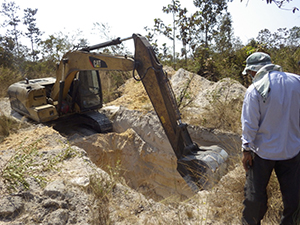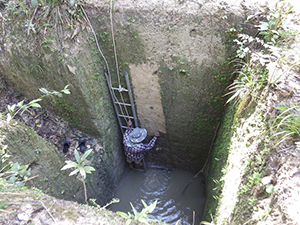Home > International Partnerships > Collaborative Research > Growth Conditions of Extremely Tall Tropical Dry Evergreen Forests with a Focus on Their Soil Moisture Supply Capacities
Update:June 6, 2024
Main content starts here.
Growth Conditions of Extremely Tall Tropical Dry Evergreen Forests with a Focus on Their Soil Moisture Supply Capacities

1. Partners
Forestry Administration, Cambodia
2. Research Period
FY 2019–2023 Grant-in-Aid for Scientific Research (KAKENHI)
3. Lead Researcher
OHNUKI, Yasuhiro (Department of Forest Soils)
4. Background
Extremely tall lowland dry evergreen forests are widely distributed in the central part of Cambodia, where there is a tropical monsoon climate with a marked dry season. However, it is commonly accepted that evergreen trees cannot grow tall under dry conditions due to water limitation. Therefore, we cannot explain how such forests have formed based on plant physiology alone.
5. Research Goal
We will clarify the mechanisms that allow trees to grow taller in central Cambodia and lowland dry evergreen forests to be maintained in extremely low rainfall environments, such as those affected by El Niño.
6. Research Strategy
We will undertake a study in extremely tall lowland dry evergreen forests in Kampong Thom Province in the Kingdom of Cambodia. Data obtained from these forests will be used to simulate soil water conditions, and the simulated results will then be verified with actual values for the level and pattern of precipitation; the evapotranspiration rate measured using a 60-m-high meteorological observation tower; and changes in the groundwater level, plant root systems, and soil water content at 20-cm depth intervals through a 9-m-deep soil profile. By simulating soil moisture transfer, we will elucidate the mechanism that provides an abundant water supply to trees during the long and severe dry season. We will also dig a 4-m-deep soil profile in dry deciduous forest near the dry evergreen forest site and quantify some of the above values for the simulation. Comparison of these sites will allow us to clarify the unique pattern of water supply in lowland dry evergreen forests.
 |
 |
|
Digging a large soil profile |
Investing the large soil profile during wet season |
7. Scientific Achievement
Through various on-site observations and measurements and soil moisture movement simulations using a numerical model, we clarified the formation mechanism of dry evergreen forests with extremely high tree heights from the perspective of water storage in deep soil layers.
8. Applications
The results of this research's field observation data and soil moisture movement simulations are used to predict the dynamics of water resources in Cambodia in the lower Mekong River Basin, where deforestation pressure has increased in recent years, assuming various scenarios such as forest degradation, reduction, and restoration.
9. Publications
Yasuhiro OHNUKI, Jumpei TORIYAMA, Eriko ITO, Shin’ichi IIDA, Naoki KABEYA, Sophal CHANN, Samkol KETH (2022) Fluctuation of Soil Water Content in the Tropical Seasonal Forests of Cambodia Focusing on Soil Types and Properties. JARQ, 56 (2), 177-187.
Jumpei TORIYAMA, Yasuhiro OHNUKI, Naoki KABEYA, Akira SHIMIZU, Takanori SHIMIZU, Shin-ichi IIDA, Koji TAMAI, Samkol KETH, Sophal CHANN (2024) Soil moisture dynamics of a lowland evergreen forest in super El Niño of monsoon Asia –An estimate by a numerical model–. Kyushu Journal of Forest Research. 77, 195-198.
Copyright © Forest Research and Management Organization. All rights reserved.
